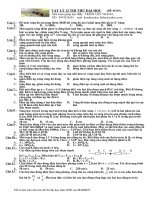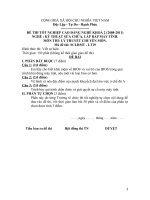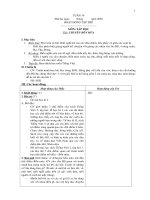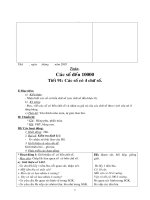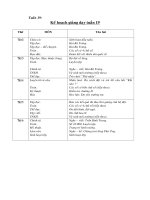PASSAGE 19
Bạn đang xem bản rút gọn của tài liệu. Xem và tải ngay bản đầy đủ của tài liệu tại đây (44.19 KB, 2 trang )
PASSAGE 19
The New York Times is a daily newspaper published in New York city. For a long time, it has been the
newspaper of record in the United States and one of the world’s great newspapers. Its strength is in its
editorial excellence; it has never been the largest newspaper in terms of circulation.
The Times was established in 1851 as a penny paper whose editors wanted to report the news in a
restrained and objective fashion. It enjoyed early success as its editors set a pattern for the future by
appealing to a cultured, intellectual readership instead of a mass audience. However, in the late nineteenth
century, it came into competition with more popular, colorful, if not lurid, newspapers in New York City.
Despite price increases, the Times was losing $1,000 a week when Adolph Simon Ochs bought it in 1896.
Ochs built the Times into an internationally respected daily. He hired Carr Van Anda as editor. Van Anda
placed greater stress than ever on full reporting of the news of the day, and his reporters maintained and
emphasized existing good coverage of international news. The management of the paper decided to
eliminate fiction from the paper, added a Sunday magazine section, and reduced the paper’s price back to
a penny. In April 1912, the paper took many risks to report every aspect of the sinking of the Titanic. This
greatly enhanced its prestige, and in its coverage of two world wars, the Times continued to enhance its
reputation for excellence in world news.
In 1971, the Times was given a copy of the so-called “Pentagon Papers,” a secret government study of
U.S. involvement in the Vietnam War. When it published the report, it became involved in several
lawsuits. The U.S. Supreme Court found that the publication was protected by the freedom-of-the-press
clause in the First Amendment of the U.S. Constitution. Later in the 1970s, the paper, under Adolph
Ochs’s grandson, Arthur Ochs Sulzberger, introduced sweeping changes in the organization of the
newspaper and its staff and brought out a national edition transmitted by satellite to regional printing
plants.
Question 1. What is the main idea of the passage?
A. The New York Times publishes the best fiction by American writers.
B. The New York Times became highly respected throughout the world.
C. The New York Times broadcasts its news to TV stations via satellite.
D. The New York Times lost its prestige after the Vietnam War.
Question 2. It can be inferred from the passage that the circulation of the New York Times is _____.
A. not the best in the world
B. the smallest in the world
C. the worst in the world
D. not the largest in the world
Question 3. Which phrase is closest in meaning to the word “restrained” in paragraph 2?
A. Put in prison
B. With self-control
C. Without education
D. In handcuffs
Question 4. What word or phrase does the word “his” as used in paragraph 3 refer to?
A. Van Anda
B. Reporters
C. News of the day
D. International news
Question 5. To improve its circulation, the management of the Times did all of the following EXCEPT
_____.
A. emphasized good coverage of international news
B. increased the number of lurid stories, even if they were not true
C. added a Sunday magazine section
D. eliminated fiction from the paper
Page 1
Question 6. The passage implies that the newspaper’s reputation _____.
A. decreased when it lowered its price to a penny
B. grew because Adolph Ochs bought it in 1896
C. decreased because it could not compete with other New York papers
D. increased because of its coverage of the Titanic’s sinking
Question 7. According to the passage, the Times has a national edition that is _____.
A. protected by the Supreme Court
B. printed in the form of a Sunday magazine
C. shipped by train and air transport daily
D. transmitted by satellite to regional
ĐÁP ÁN
1-B
2-D
6-D
7-D
3-B
4-A
5-B
Question 1:
Bài viết nói về quá trình báo The Times hình thành, phát triển và được tôn trọng qua các mốc thời gian cụ
thể
Question 2:
Thông tin nằm ở đoạn: “Its strength is in its editorial excellence; it has never been the largest newspaper
in terms of circulation.”
Question 3:
Restrained ≈ with self-control: kìm nén, kiềm chế (bản thân)
Question 4:
His được thay thế cho Van Anda ở vế trước: “Van Anda placed greater stress than ever on full reporting of
the news of the day”
Question 5:
Phương án A ở đoạn 3: “Van Anda placed greater stress than ever on full reporting of the news of the day,
and his reporters maintained and emphasized existing good coverage of international news” Phương án B
ở đoạn 3: “The management of the paper decided to eliminate fiction from the paper, added a Sunday
magazine section” Phương án D ở đoạn 3: “The management of the paper decided to eliminate fiction
from the paper, added a Sunday magazine section”
Question 6:
Thông tin nằm ở đoạn: “In April 1912, the paper took many risks to report every aspect of the sinking of
the Titanic. This greatly enhanced its prestige”
Question 7:
Thông tin nằm ở đoạn: Later in the 1970s, the paper, under Adolph Ochs’s grandson, Arthur Ochs
Sulzberger, introduced sweeping changes in the organization of the newspaper and its staff and brought
out a national edition transmitted by satellite to regional printing plants”
Page 2
